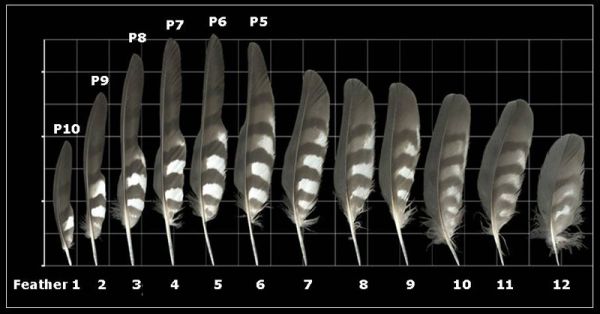
Have you ever noticed that feathers are different shapes depending on their location on a bird’s body? This is especially true of flight feathers: remiges (wings) and rectrices (tails).
Shown above are six primary and six secondary feathers from a sharp-shinned hawk. The feathers are lined up in the order they appear on the bird’s wing with the wingtip at left.
Notice how each feather is a slightly different shape than the one next to it. This difference allows each feather to contribute its own contour to the overall flight surface of the wing. In this illustration there’s a contour gap after feather P5 because only six of the sharp-shin’s ten primaries are shown — P10 to P5 — before jumping to the secondaries.
Look closely and you’ll see that the edges of the sharp-shin’s primaries are not uniformly curved. (Click here for close-up.) Instead they have notches on the wide vane and emarginations on the narrow vane.
Sharp-shinned hawks pursue small birds through the forest and make quick turns through narrow openings to avoid obstacles. This means their wings are short and their primaries are deeply notched and emarginated to accommodate their hunting style.
Peregrines’ flight requirements are much different. They dive at top speed in the open air to capture their prey. They don’t need to avoid trees so their wings are long and their feather edges are nearly smooth for rapid dives and precision flight. Click here to see that peregrines’ primary feathers are less curved the sharp-shins’. Only their P10 feather has a noticeable notch.
You can examine the feathers of many birds at The Feather Atlas website where I found this photo. It’s a National Forensic Laboratory project of U.S. Fish and Wildlife in which they make high-resolution scans of the primaries, secondaries and tail feathers of each species. There are separate scans for juveniles and females/males if the feathers look different.
I’m sure you’ll enjoy browsing the site and learning more about feather shapes.
(photo from The Feather Atlas. Click on the photo to see the original webpage. NOTE: It is illegal to possess any feather without a permit. Click here for details.)
“NOTE: It is illegal to possess any feather without a permit.”
Uh oh – I have a feather from one of the peregrines that I found on the ground near the cathedral of learning. It currently adorns my lab bench. Guess I’ll put it back where I found it